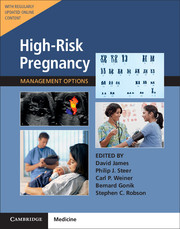Book contents
- Frontmatter
- Contents
- List of Contributors
- Preface
- Section 1 Prepregnancy Problems
- Section 2 Early Prenatal Problems
- Section 3 Late Prenatal – Fetal Problems
- Section 4 Problems Associated with Infection
- Section 5 Late Pregnancy – Maternal Problems
- 30 Substance Misuse in Pregnancy
- 31 Medication in Pregnancy
- 32 Hypertension in Pregnancy
- 33 Cardiac Disease in Pregnancy
- 34 Respiratory Disease in Pregnancy
- 35 Anemia and White Blood Cell Disorders in Pregnancy
- 36 Hematological Malignancies in Pregnancy
- 37 Thrombocytopenia and Bleeding Disorders in Pregnancy
- 38 Disorders of Coagulation in Pregnancy
- 39 Autoimmune Disease in Pregnancy
- 40 Diabetes in Pregnancy
- 41 Thyroid Disease in Pregnancy
- 42 Pituitary and Adrenal Disease in Pregnancy
- 43 Gastrointestinal and Liver Diseases in Pregnancy
- 44 Neurologic Complications in Pregnancy
- 45 Renal Disorders in Pregnancy
- 46 Spine and Joint Disorders in Pregnancy
- 47 Skin Disease in Pregnancy
- 48 Malignant Disease in Pregnancy
- 49 Pregnancy After Transplantation
- 50 Trauma in Pregnancy
- 51 Mental Health Disorders in Pregnancy
- Section 6 Late Prenatal – Obstetric Problems
- Section 7 Postnatal Problems
- Section 8 Normal Values
- Index
43 - Gastrointestinal and Liver Diseases in Pregnancy
from Section 5 - Late Pregnancy – Maternal Problems
- Frontmatter
- Contents
- List of Contributors
- Preface
- Section 1 Prepregnancy Problems
- Section 2 Early Prenatal Problems
- Section 3 Late Prenatal – Fetal Problems
- Section 4 Problems Associated with Infection
- Section 5 Late Pregnancy – Maternal Problems
- 30 Substance Misuse in Pregnancy
- 31 Medication in Pregnancy
- 32 Hypertension in Pregnancy
- 33 Cardiac Disease in Pregnancy
- 34 Respiratory Disease in Pregnancy
- 35 Anemia and White Blood Cell Disorders in Pregnancy
- 36 Hematological Malignancies in Pregnancy
- 37 Thrombocytopenia and Bleeding Disorders in Pregnancy
- 38 Disorders of Coagulation in Pregnancy
- 39 Autoimmune Disease in Pregnancy
- 40 Diabetes in Pregnancy
- 41 Thyroid Disease in Pregnancy
- 42 Pituitary and Adrenal Disease in Pregnancy
- 43 Gastrointestinal and Liver Diseases in Pregnancy
- 44 Neurologic Complications in Pregnancy
- 45 Renal Disorders in Pregnancy
- 46 Spine and Joint Disorders in Pregnancy
- 47 Skin Disease in Pregnancy
- 48 Malignant Disease in Pregnancy
- 49 Pregnancy After Transplantation
- 50 Trauma in Pregnancy
- 51 Mental Health Disorders in Pregnancy
- Section 6 Late Prenatal – Obstetric Problems
- Section 7 Postnatal Problems
- Section 8 Normal Values
- Index
Summary
Introduction
In this chapter, the gastrointestinal and hepatic disorders are considered in two groups:
• Common gastrointestinal and liver conditions that are specific to pregnancy:
• Gastrointestinal disorders
– nausea and vomiting
– hyperemesis gravidarum
– gastroesophageal reflux
– constipation
– hemorrhoids
• Liver disorders
– Intrahepatic cholestasis of pregnancy
– HELLP syndrome
– acute fatty liver of pregnancy
– liver hematoma and nontraumatic liver rupture
• Common preexisting disorders which require a proactive diagnostic or therapeutic approach. A careful consideration of the effects of maintenance drugs on the outcome of their children is justified in these patients, and this should include adequate prepregnancy counseling.
• Gastrointestinal disorders
– irritable bowel syndrome
– inflammatory bowel disease
– peptic ulceration
– celiac disease
• Liver disorders
– biliary stones
– autoimmune hepatitis
– cirrhosis, including primary biliary cirrhosis
– esophageal varices
– liver transplantation
Pregnancy-Acquired Gastrointestinal Disorders
Nausea and Vomiting; Hyperemesis Gravidarum
Nausea is one of the most common gastrointestinal symptoms during pregnancy, affecting 50–90% of pregnant women. Independent risk factors for developing nausea during pregnancy include obesity, young maternal age, first pregnancy, and smoking. The pathophysiology of nausea during pregnancy includes alterations in gastric motility, taste, smell, and vestibular function, but psychological factors may also be involved.1 Symptoms of nausea and vomiting typically arise during the first trimester. The severity can vary, with hyperemesis gravidarum (HG) being the most extreme manifestation. HG occurs in approximately 0.1% of pregnancies. Around 15% of women who experience nausea and vomiting will suffer from symptoms after the first trimester, or even for the entire duration of their pregnancy.
Diagnosis
HG is a diagnosis of exclusion. If nausea and vomiting persists into the second or third trimester, a search for other causes such as peptic ulceration, systemic infection, pancreatitis, and Addison's disease should be performed. An extensive list of diseases that are associated with nausea and vomiting during pregnancy is provided in Table 43.1. HG reccurs in 15–20% of women with a history of HG, compared to 0.7% in women without a history of HG.
- Type
- Chapter
- Information
- High-Risk Pregnancy: Management OptionsFive-Year Institutional Subscription with Online Updates, pp. 1236 - 1272Publisher: Cambridge University PressFirst published in: 2017



